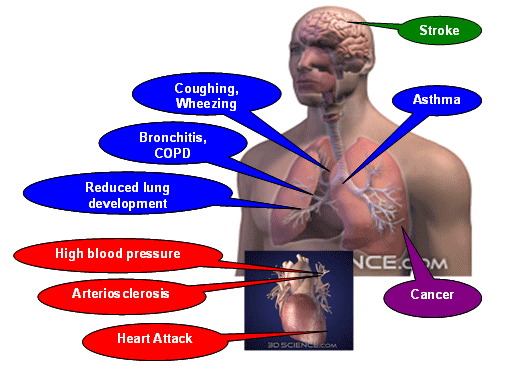HEALTH AND ENVIRONMENTAL EFFECTS
Breathing air with smog has adverse and varied consequences
for human health, with the cardio-respiratory system being the main target of
concern. Wherever its location and
whether visible or not, smog is hazardous to human health.
Ground-level ozone has been linked with a broad spectrum of
human health effects. Because of its
reactivity, ozone can injure biological tissues and cells. Exposure to ozone has been associated with
mortality, hospital admissions, emergency department visits and other adverse
health effects.
Exposure to airborne particles at the levels typically found
in North American urban areas is associated with a variety of adverse
effects. Particles can irritate the
eyes, nose, and throat and cause coughing, breathing difficulties, reductions
in lung functions, and an increase in the use of asthma medication. Exposure to particles is also associated with
an increase in the number of emergency department visits, an increase in
hospitalizations of people with cardiac and respiratory disease, and in
premature morality.
There is clear evidence of the harmful effects of these
pollutants throughout the range of concentrations to which Canadians are
exposed. This means that any reduction
in the ambient levels of these pollutants provides a reduction in population
health risk.
Negative effects on the environment associated with these
pollutants include visibility impairment and ecosystem acidification (for PM),
and crop damage and greater vulnerability to diseases in some tree species (for
ozone).
All of these adverse effects lead to significant economic
losses and reductions in productivity as a result of absenteeism from school
and work, in creased medical care and hospitalizations, and reduced product quality
and yields.

Summary
PM and ground-level ozone are two principal components that
comprise smog. These pollutants pose
serious health and environmental concerns.
Ozone is a secondary pollutant because it is not emitted directly to the
atmosphere but rather is formed in air from complex reactions between the
precursor gases NOx and VOC in the presence of sunlight. PM has both a primary and a secondary
component. Primary PM is released
directly to the atmosphere from combustion or mechanical processes. Secondary PM is formed in the atmosphere from
the precursor gases SO2, NOx, VOC and NH3. PM and ozone can be transported by prevailing
air flows over long distances, making them not only a concern for urban centres
across Canada but also for many smaller communities and rural areas.
Breathing air with smog has adverse and varied consequences
for human health, with the cardio-respiratory system being the main target of
concern. There is clear evidence of the
harmful effects of PM2.5
and ozone throughout the range of
concentrations to which Canadians are exposed.


